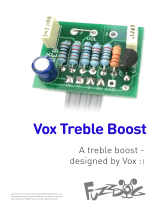Page is loading ...

AstroTone
Clone of the Astro Tone Fuzz /
Sam Ash Fuzzz Boxx
Contents of this document are ©2016 Pedal Parts Ltd.
No reproduction permitted without the express written
permission of Pedal Parts Ltd. All rights reserved.

Schematic
BOM
R1 1M
R2 22K
R3 1M
R4 470K
R5 1K8
R6 1K8 (470R)
R7 CLR (2K2)
C1 47n (470n)
C2 47n
C3 47n
C4 47n (470n)
C5 47u elec
Q1,2 2N2222*
D1-2 1N4148
D3** 1N4148
ATTACK 100KB
TONE 10KB
VOL 10KA
Components listed in blue are for a ‘boutique’ version.
*any low-ish gain NPN silicon transistors could be tried, for instance 2N3904, 2N5088,
BC109, though we can’t vouch for the results. Note the pinouts though.
SEE NOTE OVERLEAF BEFORE PLACING!
**D3 was in Sam Ash version, but not original. Can be replaced with a jumper wire.
E
B
C
PCB Layout ©2016 Pedal Parts Ltd.
E
B
C

TRANSISTOR PINOUTS
Manufacturers can be very unhelpful sometimes. Different versions of 2N2222 may have
different pinouts. Check your datasheet if sourcing your own parts.
If you’re building a FuzzDog kit, your transistors will be one of the following:
PN2222 - these should be mounted as per the component silkscreen.
P2N2222 - these have the opposite pinout, and should be reversed.
The power and signal pads on the PCB conform to the FuzzDog Direct Connection format,
so can be paired with the appropriate daughterboard for quick and easy offboard wiring.
Be very careful when soldering the transistors, LED and diodes. They’re very sensitive to
heat. You should use some kind of heat sink (crocodile clip or reverse action tweezers) on
each leg as you solder them. Keep exposure to heat to a minimum (under 2 seconds).
The cathode (striped end) of the diodes go into the square pads. The anode (long leg) of
electrolytic capacitor goes into the square pad.
Snap the small metal tag off the pot so it can be mounted flush in the enclosure.
If you’re using a footswitch daugherboard don’t bother soldering R7. You’ll use that on the
daughterboard instead.

Test the board!
UNDER NO CIRCUMSTANCES will troubleshooting help
be offered if you have skipped this stage. No exceptions.
Once you’ve finished the circuit it makes sense to test is before
starting on the switch and LED wiring. It’ll cut down
troubleshooting time in the long run. If the circuit works at this
stage, but it doesn’t once you wire up the switch - guess what?
You’ve probably made a mistake with the switch.
Solder some nice, long lengths of wire to the board connections for
9V, GND, IN and OUT. Connect IN and OUT to the jacks as shown.
Connect all the GNDs together (twist them up and add a small
amount of solder to tack it). Connect the battery + lead to the 9V
wire, same method. Plug in. Go!
If it works, crack on and do your switch wiring. If not... aw man.
At least you know the problem is with the circuit. Find out why, get
it working, THEN worry about the switch etc.
BATTERY
IN OUT
Your nice, new circuit board
INCLUDING WIRED POTS!!!!
IN 9V GND OUT

(if using a daughterboard please refer to the relevant document)
Wire it up - with battery
This circuit is standard, Negative GND. Your power supply should be
Tip Negative / Sleeve Positive. That’s the same as your standard pedals
(Boss etc), and you can safely daisy-chain your supply to this pedal.
The BOARD GND connections don’t all have to connect to one point.
They can be daisy-chained around the circuit, using larger connection
points (such as jack socket lugs) for multiple connections. As long as
they all connect together in some way.
L
E
D
BOARD
OUT
BOARD
9V
BOARD
GND
BOARD
GND
BOARD
GND
BOARD
INPUT
BATTERY
+
IN
OUT
L
E
D
BOARD
GND
BOARD
LED+
+

(if using a daughterboard please refer to the relevant document)
Wire it up - DC only version
This circuit is standard, Negative GND. Your power supply should be
Tip Negative / Sleeve Positive. That’s the same as your standard pedals
(Boss etc), and you can safely daisy-chain your supply to this pedal.
The BOARD GND connections don’t all have to connect to one point.
They can be daisy-chained around the circuit, using larger connection
points (such as jack socket lugs) for multiple connections. As long as
they all connect together in some way.
PedalParts.co.uk
L
E
D
BOARD
OUT
BOARD
9V
BOARD
GND
BOARD
GND
BOARD
GND
BOARD
INPUT
+
IN
OUT
L
E
D
BOARD
GND
BOARD
LED+

This template is a rough guide only. You should ensure correct marking of your
enclosure before drilling. You use this template at your own risk.
Pedal Parts Ltd can accept no responsibility for incorrect drilling of enclosures.
PedalParts.co.uk
Drilling template
Hammond 1590B
60 x 111 x 31mm
It’s a good idea to drill the
pot holes 1mm bigger if you’re
board-mounting them.
Wiggle room = good!
Recommended drill sizes:
Pots 7mm
Jacks 10mm
Footswitch 12mm
DC Socket 12mm
32mm
21mm
/









